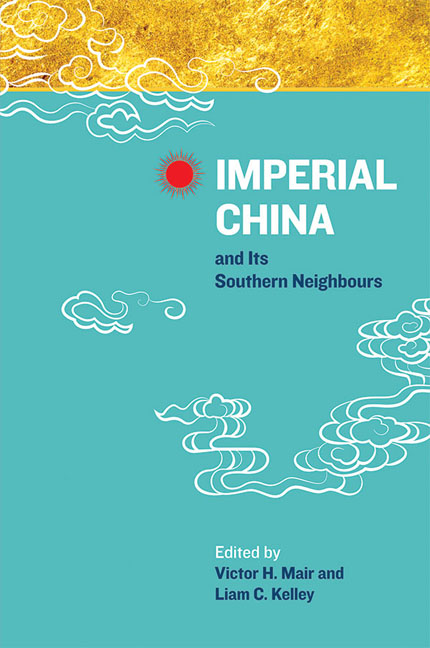Book contents
- Frontmatter
- Contents
- Preface
- The Contributors
- 1 Introduction: Imperial China Looking South
- 2 Layers of Meaning: Hairstyle and Yue Identity in Ancient Chinese Texts
- 3 Sinicization and Barbarization: Ancient State Formation at the Southern Edge of Sinitic Civilization
- 4 Clothes Make the Man: Body Culture and Ethnic Boundaries on the Lingnan Frontier in the Southern Song
- 5 What Makes a Chinese God? or, What Makes a God Chinese?
- 6 Dragon Boats and Serpent Prows: Naval Warfare and the Political Culture of China's Southern Borderlands
- 7 Inventing Traditions in Fifteenth-century Vietnam
- 8 Epidemics, Trade, and Local Worship in Vietnam, Leizhou Peninsula, and Hainan Island
- 9 Southeast Asian Primary Products and their Impact on Chinese Material Culture in the Tenth to Seventeenth Centuries
- 10 New Evidence on the History of Sino'arabic Relations: A Study of Yang Liangyao's Embassy to the Abbasid Caliphate
- 11 The Peacock's Gallbladder: An Example of Tibetan Influence in Late Imperial China
- 12 Transformation of the Yunnanese Community Along the Sino–burma Border During the Nineteenth and Early Twentieth Centuries
- 13 How the North Tried to Pacify the South Through Ritual Practices: On the Origins of the Guan Suo Opera in the Nineteenth Century
- 14 Realms Within Realms of Radiance, or, can Heaven Have Two Sons? Imperial China as Primus Inter Pares among Sino–pacific Mandala Polities
- Index
- Nalanda-Sriwijaya Series
12 - Transformation of the Yunnanese Community Along the Sino–burma Border During the Nineteenth and Early Twentieth Centuries
Published online by Cambridge University Press: 06 January 2018
- Frontmatter
- Contents
- Preface
- The Contributors
- 1 Introduction: Imperial China Looking South
- 2 Layers of Meaning: Hairstyle and Yue Identity in Ancient Chinese Texts
- 3 Sinicization and Barbarization: Ancient State Formation at the Southern Edge of Sinitic Civilization
- 4 Clothes Make the Man: Body Culture and Ethnic Boundaries on the Lingnan Frontier in the Southern Song
- 5 What Makes a Chinese God? or, What Makes a God Chinese?
- 6 Dragon Boats and Serpent Prows: Naval Warfare and the Political Culture of China's Southern Borderlands
- 7 Inventing Traditions in Fifteenth-century Vietnam
- 8 Epidemics, Trade, and Local Worship in Vietnam, Leizhou Peninsula, and Hainan Island
- 9 Southeast Asian Primary Products and their Impact on Chinese Material Culture in the Tenth to Seventeenth Centuries
- 10 New Evidence on the History of Sino'arabic Relations: A Study of Yang Liangyao's Embassy to the Abbasid Caliphate
- 11 The Peacock's Gallbladder: An Example of Tibetan Influence in Late Imperial China
- 12 Transformation of the Yunnanese Community Along the Sino–burma Border During the Nineteenth and Early Twentieth Centuries
- 13 How the North Tried to Pacify the South Through Ritual Practices: On the Origins of the Guan Suo Opera in the Nineteenth Century
- 14 Realms Within Realms of Radiance, or, can Heaven Have Two Sons? Imperial China as Primus Inter Pares among Sino–pacific Mandala Polities
- Index
- Nalanda-Sriwijaya Series
Summary
The Chinese province of Yunnan was officially brought under the administrative control of Imperial China during the Yuan Dynasty through the Mongol army's southwest campaigns. However, the central government's exertion of control in this remote periphery was not as strong as that in the northern or eastern parts of Imperial China. In many aspects, Yunnan maintained its frontier identity at a crossroads between East, South, and Southeast Asia. The traditional caravan trade that linked China and India can be traced at least to the Han Dynasty, and it remained a vital channel of interaction and exchange for the region throughout history, despite occasional interruptions such as the Sino-Burmese War (1762–69). Even with an increasing Han population and an intensified process of Sinification from the Ming Dynasty onwards, many areas were governed by native officials, who often held multiple, but nominal, loyalties to remote power centres in China, Siam and Burma well into the nineteenth century, a feature which has been identified more with Southeast Asian polities than with their counterpart based in Beijing.
However, in the late eighteenth century, this balance was abruptly interrupted by the arrival of the European colonial powers. The expanding northeastern frontier of the colonial state of British India (or of its predecessor until 1857, the East India Company) was directly confronted by Imperial China's southwest periphery. Unlike contemporary confrontations along the southern and eastern coasts of China, Yunnan experienced neither wars nor concessions of its territories. Nevertheless, the colonial presence challenged the free-flowing tradition of the frontier, and to some extent, defined Imperial China's southwest border immediately prior to the fall of the Qing Dynasty.
The current study looks at one group from this frontier region, the Han Yunnanese, who traditionally sojourned between western Yunnan and Upper Burma. In response to the approaching colonial presence — and from 1886 onwards, with the newly established colonial rule in Burma — this group underwent a communal transformation with reinforced or newly created identities, which reflected the demarcation of political borders and the delineation of ethnic boundaries in one of the remotest peripheries of Imperial China and in its southern neighbour, Burma.
- Type
- Chapter
- Information
- Imperial China and Its Southern Neighbours , pp. 291 - 315Publisher: ISEAS–Yusof Ishak InstitutePrint publication year: 2015

